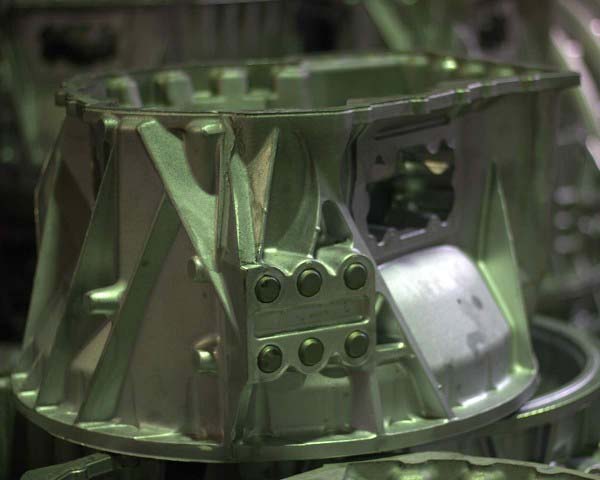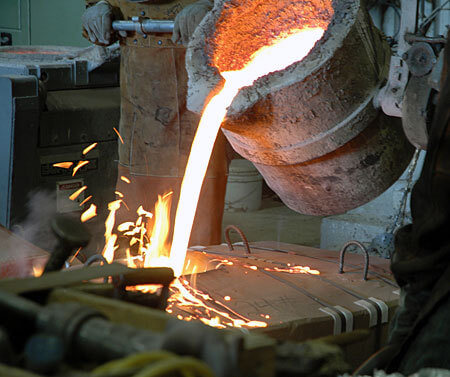Innovations Driving Precision aluminum casting Technology
Wiki Article
Aluminum Casting Explained: Trick Facts and Insights for Market Professionals
Aluminum casting serves as a crucial process in modern-day production, forming elements throughout numerous industries. Its varied methods, such as sand and die casting, accommodate various manufacturing requirements. The unique homes of aluminum alloys enhance their applicability, yet challenges remain in keeping high quality and effectiveness. Recognizing these aspects is necessary for market specialists. What are the most recent advancements and ideal methods that can additionally maximize this procedure?Summary of Aluminum Casting Processes

Secret aspects of aluminum casting processes include the prep work of mold and mildews, which may be made from sand, metal, or ceramic materials, depending upon the meant usage. Additionally, temperature control is critical to ensure correct melting and solidification of aluminum.
The casting procedure enables elaborate styles and can attain high degrees of dimensional accuracy. Once cooled, the castings may go through finishing operations such as machining or surface treatment to satisfy certain performance requirements. Generally, aluminum casting works as a versatile production strategy, effectively fulfilling the diverse demands of various industries.
Kinds Of Aluminum Casting Methods
In the domain name of aluminum casting, different methods are employed to achieve various results. Sand casting strategies provide flexibility and cost-effectiveness for complicated forms, while die casting procedures supply high precision and effectiveness for mass production. Comprehending these techniques is important for selecting the ideal technique based on job needs.Sand Casting Strategies
Sand casting strategies stand for a fundamental technique in aluminum casting, where sand is made use of as a mold material to form molten steel. This process includes developing a pattern from the desired component, which is then put in a sand mixture to develop a mold and mildew. The sand is compressed around the pattern, and after elimination, it develops a cavity in the shape of the component. Molten aluminum is poured right into this tooth cavity, permitting it to cool and solidify. One substantial benefit of sand casting is its versatility; it can accommodate complicated shapes and huge parts. Furthermore, the materials utilized are fairly affordable, making it an available choice for numerous manufacturing applications in the aluminum market.Die Casting Processes
Die casting procedures are a noticeable method for forming aluminum components, utilizing high-pressure strategies to force molten metal into exactly engineered mold and mildews. This process is particularly preferred for its ability to create complicated shapes with tight resistances and a smooth surface. There are two primary sorts of die casting: hot chamber and cool chamber. Hot chamber die casting appropriates for steels with low melting factors, permitting faster manufacturing prices. Alternatively, chilly chamber die casting is perfect for higher melting factor steels, calling for a different melting furnace. Both techniques boost performance and lower material waste, making them essential in auto, aerospace, and durable goods markets. Understanding these processes aids experts pick one of the most ideal technique for their specific applications.Product Quality of Aluminum Alloys

Toughness and Durability
Strength and durability are critical characteristics of aluminum alloys that make them ideal for numerous casting applications. These products exhibit a favorable strength-to-weight ratio, enabling for the development of light-weight yet durable components. When it come to tensile toughness, specific aluminum alloys can be engineered to endure substantial lots without deforming. This building is specifically essential in industries such as aerospace and automobile, where performance and safety and security are paramount. In addition, aluminum alloys often maintain their mechanical buildings under diverse temperature conditions, making certain constant efficiency. The innate ductility of these alloys also permits reliable shaping during the casting procedure, making it much easier to create complex geometries. Overall, the stamina and toughness of aluminum alloys add significantly to their prevalent use in advanced applications.Corrosion Resistance Characteristics
While aluminum alloys are valued for their toughness and light-weight properties, their rust resistance is an additional vital feature that enhances their suitability for numerous applications. Aluminum normally creates a protective oxide layer when exposed to dampness, which aids to stop more oxidation. This inherent building makes aluminum alloys particularly beneficial in atmospheres prone to corrosion, such as aquatic and commercial setups. Furthermore, various alloy compositions can influence resistance degrees, with particular alloys particularly engineered to enhance this particular. Therapies like plating can better boost corrosion resistance by thickening the oxide layer. Understanding the deterioration resistance of aluminum alloys is crucial for industry specialists when selecting products for projects requiring sturdiness and durability in challenging environments.Benefits of Aluminum Casting in Production
Aluminum casting offers various advantages in manufacturing, making it a recommended choice for numerous industries. One substantial benefit is its light-weight nature, which adds to lowered transportation expenses and improved energy effectiveness in final product. Furthermore, aluminum's exceptional thermal and electrical conductivity enhances performance in applications requiring heat dissipation or electrical conduction.The material's ability to be cast into intricate shapes enables design adaptability, reducing the need for added machining processes. In enhancement, aluminum casting exhibits remarkable rust resistance, causing longer item life expectancies and reduced maintenance prices.

Typical Applications of Aluminum Castings
The adaptability of aluminum casting enables its prevalent use across numerous industries. Common applications consist of automotive components, where light-weight and corrosion-resistant parts, such as engine blocks and transmission real estates, enhance vehicle performance. In the aerospace sector, aluminum castings are utilized for architectural parts, supplying stamina without adding considerable weight.
In addition, the electric sector take advantage of aluminum castings in producing units and heat sinks, where thermal conductivity is essential. The customer products market also includes aluminum spreadings in items like cooking equipment, furniture, and attractive products, combining appearances with performance.
The construction market utilizes aluminum spreadings for architectural aspects, window frameworks, and fixtures, which offer durability and layout flexibility. Generally, the helpful site varied applications of aluminum castings underscore their value in modern-day production, adding to improvements in performance and product layout throughout multiple fields.
Developments and Technical Developments
As industries continue to advance, innovations in aluminum casting technology are transforming manufacturing procedures and product capabilities. Innovations in 3D printing and additive production have actually made it possible for the creation of complex geometries that were formerly difficult to attain with conventional techniques. These innovations permit for quick prototyping, decreasing lead times and expenses.Additionally, renovations in mold and mildew design and products have improved the casting procedure by raising efficiency and minimizing waste. The combination of wise manufacturing strategies, such as IoT tools and real-time data analytics, permits better tracking and optimization of production criteria, resulting in greater high quality results.
Additionally, growths in aluminum alloys supply improved toughness, corrosion resistance, and lightweight properties, satisfying the expanding needs in automotive and aerospace sectors. Jointly, these advancements are not only boosting productivity yet likewise satisfying the rigorous requirements of modern-day design applications.
Ideal Practices for High Quality Control in Aluminum Casting
Making sure high-quality results in aluminum casting needs adherence to best practices that encompass different phases of the production procedure. First, complete material evaluation is necessary to verify the top quality of aluminum alloys utilized, as contaminations can substantially impact the last item. Implementing precise melting and pouring techniques reduces problems; keeping ideal temperature levels avoids oxidation and advertises harmony.Furthermore, mold style plays a vital function; utilizing computer-aided design (CAD) can improve accuracy and reduce human mistake. Routine tracking of the cooling process is crucial to avoid warping and shrinkage. In addition, making use of non-destructive testing approaches, such as ultrasonic or X-ray examinations, helps recognize interior imperfections without damaging the elements.
Establishing a feedback loophole with operators and engineers fosters continual enhancement, guaranteeing that quality control measures advance alongside technological advancements. By following these best techniques, producers can enhance the dependability and performance of aluminum spreadings.
Frequently Asked Questions
What Are the Ecological Influences of Aluminum Casting?
The ecological impacts of aluminum casting include considerable energy usage, greenhouse gas discharges, and possible water air pollution from factory procedures. In addition, bauxite mining for aluminum ore can cause habitat devastation and soil destruction.How Does Aluminum Casting Contrast to Other Steel Casting Processes?
Aluminum casting generally supplies advantages in lightweight parts and corrosion resistance contrasted to various other processes, such as iron or steel casting, which may supply better toughness yet lead to larger and much less corrosion-resistant products. - Aluminum FoundryWhat Are Usual Defects in Aluminum Castings and Their Reasons?
Typical issues in aluminum spreadings include porosity, contraction, and inclusions. Reasons frequently originate from incorrect putting methods, continue reading this inadequate mold design, or contamination of the liquified metal, impacting the final product's integrity and efficiency.What Safety Preventative Measures Should Be Taken Throughout Aluminum Casting?
Throughout aluminum casting, crucial security precautions consist of using safety gear, making sure proper air flow, preserving a tidy office, taking care of liquified metal with treatment, and following well-known protocols to lessen threats Check This Out of burns, breathing hazards, and crashes.Exactly How Can I Improve the Effectiveness of My Aluminum Casting Procedures?
To improve performance in aluminum casting procedures, one need to optimize mold style, streamline material handling, employ automated procedures, perform regular maintenance on equipment, and buy staff member training to enhance skills and productivity.Different methods exist, aluminum casting incorporates a number of primary procedures that cater to different applications and needs. Trick components of aluminum casting processes consist of the preparation of molds, which might be made from sand, steel, or ceramic products, depending on the meant usage. Sand casting methods represent an essential method in aluminum casting, where sand is used as a mold and mildew product to shape molten metal. As sectors continue to progress, developments in aluminum casting modern technology are changing production processes and product abilities. Guaranteeing high-grade outputs in aluminum casting calls for adherence to finest techniques that incorporate numerous phases of the production process.
Report this wiki page